News tagged ‘design’
SoundClip: Passive iPhone Amplifier
The is a piece of plastic. It directs sound from iPhone toward you to increase the clarity and volume for movies and music. It also makes games easier to play without blocking your iPhone's speaker. SoundClip amplifies iPhone audio by 10dB between 6kH and 20kHz, resulting in a cleaner, more accurate response. The cost is $8.
7 Cities TD - Tower Defence game [AppStore]

7 Cities TD is a Tower Defense game staged to the backdrop of the beautiful Amazon region. You are The Defender, tasked with building towers along the Amazon rivers to protect the ancient Golden Cities, and stop the pirates and their evil minions.
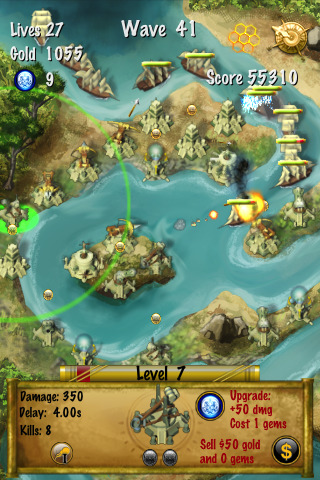

The game looks really nice. However it costs $4.99 (AppStore ).
Features:
- 7 unique hand-drawn maps ranging in difficulty and design
- 2 game modes: Campaign and Survival
- 7 towers: each with an unique look and abilities
- Upgrade your towers and level them up
- 12 individual tower skills that can be unlocked and acquired as towers gain experience and reach higher levels
- A wide variety of enemies: from small scout ships to gigantic creatures of the deep seas
- High-quality 2D graphics, animations, fully dynamic particle systems featuring fire, smoke, ice, and fireworks!
- Original music and sound effects (or you can listen to your own iPod music while playing)
- Camera pan & zoom
- Save & load any time
- Online high score submission & ranking (http://neptune-studios.com/7/highscores/)
- Pirates!
Watch 3 videos:
 Leave a comment, read comments [2]
Leave a comment, read comments [2]
Virtual reality from Apple
The US Patent Office today published two Apple that reveal the company having researched a unique head-tracking display technology designed to replicate the theater experience. A head-mounted display with head-tracking technology intended to reduce viewer fatigue and disorientation by simulating a theater or other viewing environment.
The wearer of the device can pick a seat in the fake theater and then manipulate the image, zoom in and out, and look around thanks to an accelerometer and gyroscope built into the goggles.
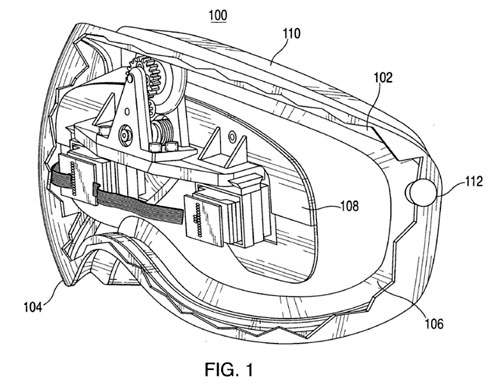
MID device: another iPhone killer?

Intel showed off a prototype handheld based on Moorestown, its upcoming Mobile Internet Device (MID) platform designed to enable a new generation of ultra-thin, touchscreen devices with extensive battery life.
Moorestown will consist of a system-on-a-chip (SOC), codenamed "Lincroft," which integrates a 45nm processor, graphics, memory controller and video encode/decode onto a single part. The platform will support a range of wireless technologies including 3G, WiMAX, WiFi, GPS, Bluetooth and mobile TV.
The divice will be avaliable sometime in the 2009-2010 time. Here is a video with presentation from IDF:
"Gadget of the Year" award goes to...

... Apple iPhone 3G. Congratulations!
The devices that competed against the iPhone 3G were as follows: Microsoft’s Xbox 360 console, Nintendo’s Wii Fit, and B&W’s Zeppelin iPod speakers. All of the products up for this honor were judged in categories including performance, design and value, as well as “cool factor”.
via theiphoneblog
New iPod touch internals
The folks at iFixIt received a brand new iPod Touch, which they disassembled right away.
Both the touch's 3.5-inch LCD display as well as its Lithium-ion polymer battery are held in place with strips of double-sided tape. The WiFi antenna and circuitry, which are located at the top of the unit, are connected to the main logic board by wide orange cable that were designed to prevent external noise from interfering with the digital signals as they travel along the device, iFixIt says.
The specialty online reseller, which offers replacement parts for Macs and iPods, was particularly excited by its discovery of an unpublicized Broadcom BCM4325 Bluetooth chip within the device. The particular chipset supports BT2.1+EDR, and is necessary for the touch's built-in support of Nike+ iPod technology. It's unclear, however, whether the chip supports A2DP, which would pave the way for Apple and third-party developers to introduce stereo headphones for the player.
iFixIt also discovered brown rectangular component centered about three quarters of the way down the touch's logic board, which is suspected to be the device's speaker. Other discoveries include a 3.7 V Lithium-ion polymer battery with part number 616-0404, NAND flash memory from Micron with part number 29F64G08TAA, and an Apple-branded Samsung-manufactured ARM processor with SDRAM that's similar to the one employed by the iPhone.
via appleinsider and ifixit
 Leave a comment, read comments [1]
Leave a comment, read comments [1]
QuickPwn, PwnageTool and WinPwn

There are so many tools, some for Mac OS, others for Windows, different versions... Complicated. So let's summerize a little bit.
If you have iPhone 3G, you'll be able to install 3-rd party non AppStore applications (through separate applications called Cydia and Installer) and run these applications. If you have old iPhone, in addition to that you'll be able to unlock the device (use with any carrier).
There are two methods: quickpwn and custom firmware method. First one is for quikly pwning and jailbreaking the device without restore. You should use it if you have unlocked device or an AT&T contract.
If you are Windows user:
- Go for . The current version is 2.5.0.2 (also called 2.5 beta-2). Download . It supports both iPhone and iPhone 3G, firmwares 2.0, 2.0.1, 2.0.2. You can use either quickpwn or custom firmware method.
- There is a separate tool for Windows. The current version is RC3. Download . Do you need it? Yes, if you want to quick pwn and you do not like WinPwn (or you had problems with it).
If you're using Mac OS:
- Go for PwnageTool. The current version is 2.0.3.1. Download . Works with 2.0, 2.0.1, 2.0.2 firmwares using custom-firmware method.
- There is a version of QuickPwn tool for MAC OS. The current version is 1.0.0. Download . It works only with firmware 2.0.2. Do you need it? Yes, if you want to quick pwn.
QuickPwn is not a replacement for PwnageTool, they are different tools and provide different features, QuickPwn is for quickly pwning a device, whereas PwnageTool is designed to custom build and tailor the ipsw production process, both tools will be actively developed in the future.
QuickPwn updated to 1.2.0
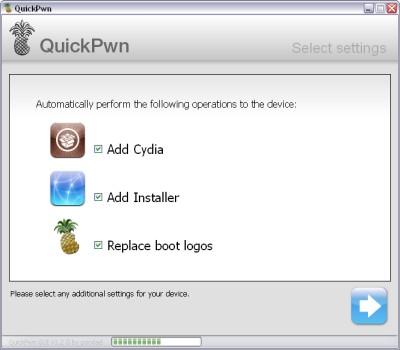
QuickPwn for Windows is updated. Support for all 2.x firmwares is added. So now you can QuickPwn and jailbreak the device if it is running 2.0, 2.0.1 or 2.0.2.
DevTeam reminds that it is still beta software, so usual rules apply, no complaints if anything goes wrong and use the tool at at your own risk!
Using QuickPwn does not update the firmware itself, this tool is designed to ‘Pwn’ (the ability to install future custom non-Apple firmwares) , ‘Jailbreak’ and install Installer and/or Cydia on a given device. If your device is running 2.0.1 and you QuickPwn it, it’ll still be running 2.0.1, although it will now be Pwned and Jailbroken. It will also activate (not unlock) devices that are being used outside of their intended territories and cannot be activated using iTunes.
If you want to update to 2.0.2 then use the normal iTunes update to get to 2.0.2 and then use QuickPwn to Pwn, Jailbreak and Activate, remember that the 2.0.2 update includes a baseband update for the 3G iPhone, so depending what your long term intentions are for the phone, update wisely, of course in the upcoming PwnageTool application you’ll be able to create a custom ipsw without the baseband update enabled.
PS: Mac OS version is on it's way.
New version of iTunes is 7.7.1
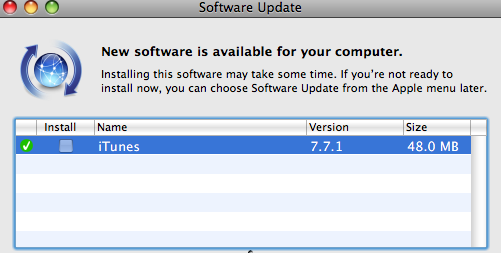
No direct download link yet. Just run iTunes and hit updates. The update includes "fixes to improve stability and performance".
Use iTunes 7.7 to sync music, video, and more with iPhone 3G, and download applications from the iTunes Store exclusively designed for iPhone and iPod touch with software version 2.0 or later. Also use the new Remote application for iPhone or iPod touch to control iTunes playback from anywhere in your home — a free download from the App Store.
iTunes 7.7.1 includes fixes to improve stability and performance.
NES emulator 2.0.3
The new version of the popular for the iPhone and iPod touch now includes accelerometer control for all games. The implementation is very simple: A tilt is equivalent to controlling input in that direction. This means that tilt control can be used in any game loaded into the emulator, but also that some of the controls are pretty much balls. Also, this app does not live in the official app store. NES.app 2.3.0 with tilt control is available now in Cydia.
As seen in the video, controlling Mario is fairly natural, though quick turns and exact jumps are difficult to execute (playing Mario with the stock controls is often worse, though). Bomberman sort of works, but in that case—and many others—the old touch control overlay is much easier. Obviously none of these games were designed with tilt control in mind, but a surprising number are at least playable.
via gizmodo
Installer for 2.0 firmware soon
It will be called Installer 4, completely redesigned and with a new nice looking interface. When it's done, it will be multi-threaded (meaning everything doesn't come to a halt while your sources are being updated) and support package dependencies as well. It will also have a new model for storing the info about applications, better and faster one.
MacBook prices will be lower

Investment bank Piper Jaffray said Tuesday it believes Apple is readying new iPod and notebook products that will apply downward pressure to profit margins because they'll be priced more affordably, such as 13-inch MacBook that will fetch less than $1000.
"We believe there is an 80% chance Apple will introduce redesigned MacBooks and possibly new MacBook Pros at lower price points," he wrote. "Specifically, Apple may re-enter the $999 price point (currently $1099) with the MacBook, or test the $1,799 price point with the MacBook Pro (currently $1999)."
The Piper Jaffray analyst reiterated his Buy rating and $250 price target on shares of Apple.
--
via appleinsider
Stereo Bluetooth A2DP Adapter for iPhone
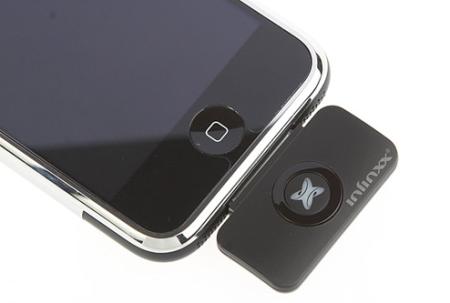
IPhone and IPhone3G do not support A2DP technology. Now they do
"A2DP is designed to transfer a uni-directional 2-channel stereo audio stream, like music from an MP3 player, to a headset or car radio." - .
This device will work on iPhone, iPhone 3G, iPod nano, iPod Color and iPod Mini. The price is $62 at .
Specifications:
- Bluetooth Version: Version 2.0 compliant, Class II
- Bluetooth Support profile: A2DP, AVRCP
- RF Frequency: 2.4GHz / 79 Channel / AFH
- Coverage Range: Bluetooth standard 33 feet (10 meters)
- Power Supply: DC 3.3V
More IPhone 3G internals photos
Portelligent and Semiconductor Insights published a document describing interals of IPhone 3G. described the details. (Previous IPhone 3G internals photos can be viewed )
Commuunications (3G/GSM) are on Infineon chips. One for GSM/GPRS/EDGE, another for WCDMA/HSDPA (3G). GPS module is not SiRF as we all thought. Apple uses . The Hammerhead II integrates an assisted-GPS (A-GPS) baseband processor with a low-noise GPS RF front end and multi-path mitigation to avoid large errors in urban environments.
 Leave a comment, read comments [2]
Leave a comment, read comments [2]
Java VM for IPhone
JamVM is a new Java Virtual Machine which conforms to the JVM specification version 2 (blue book). In comparison to most other VM's (free and commercial) it is extremely small, with a stripped executable on PowerPC of only ~200K, and Intel 180K. However, unlike other small VMs (e.g. KVM) it is designed to support the full specification, and includes support for object finalisation, Soft/Weak/Phantom References, class-unloading, the Java Native Interface (JNI) and the Reflection API.JamVM currently only includes an interpreter (keeps it small). However, the interpreter is highly optimised, and performance is on par with a simple JIT. As most of the code is written in C it is easy to port to new architectures.